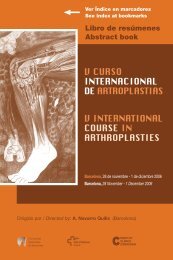Notas / Notes - Active Congress.......
Notas / Notes - Active Congress.......
Notas / Notes - Active Congress.......
Create successful ePaper yourself
Turn your PDF publications into a flip-book with our unique Google optimized e-Paper software.
JUEVES / THURSDAY<br />
144<br />
2. Burnett RS, Bourne RB: Indications for patellar resurfacing<br />
in total knee arthroplasty. J Bone Joint Surg 85A: 728-<br />
745, 2003.<br />
3. Dennis DA. The role of patellar resurfacing in TKA. Orthopedics.<br />
29(9):832, 834-5, 2006.<br />
4. Enis JE, Gardner R, Robledo MA, Latta L, Smith R: Comparison<br />
of patellar resurfacing versus nonresurfacing in<br />
bilateral total knee arthroplasty. Clin Orthop 260: 38-42,<br />
1990.<br />
5. Forster H, Fisher J: The influence of continuous sliding<br />
and subsequent surface wear on the friction of articular<br />
cartilage. Proc Inst Mech Eng 213:329-345, 1999.<br />
6. Han I, Chang CB, Lee S, Lee MC, Seong SC, Kim TK:<br />
Correlation of the condition of the patellar articular cartilage<br />
and patellofemoral symptoms and function in osteoarthritic<br />
patients undergoing total knee arthroplasty. J Bone Joint<br />
Surg. Br. 87(8): 1081-4, 2005.<br />
7. Holt GE, Dennis DA. The role of patellar resurfacing in<br />
total knee arthroplasty. Clin Orthop Relat Res. 416:76-<br />
83, 2003.<br />
8. Kajino A, Yoshino S, Kameyama S, Kohda M, Nagashima<br />
S: Comparison of the results of bilateral total knee<br />
arthroplasty with and without patellar replacement for<br />
rheumatoid arthritis: A follow-up note. J Bone Joint Surg<br />
Am 79A: 570-574, 1997.<br />
9. Khatod M, Codsi M, Bierbaum B: Results of resurfacing<br />
a native patella in patients with a painful total knee<br />
arthroplasty. J Knee Surg. 17(3): 151-5, 2004.<br />
10. Nizard RS, Biau D, Porcher R, Ravaud P, Bizot P,<br />
Hannouche D, Sedel L: A meta-analysis of patellar replacement<br />
in total knee arthroplasty. Clin Orthop Relat Res.<br />
432:196-203, 2005.<br />
11. Pakos EE, Ntzani EE, Trikalinos TA: Patellar resurfacing<br />
in total knee arthroplasty. A meta-analysis. J Bone Joint<br />
Surg Am. 87(7): 1438-45, 2005.<br />
12. Parvizi J, Rapuri VR, Saleh KJ, Kuskowski MA, Sharkey<br />
PF, Mont MA: Failure to resurface the patella during total<br />
knee arthroplasty may result in more knee pain and secondary<br />
surgery. Clin Orthop Relat Res. 438:191-6, 2005.<br />
13. Waters TS, Bentley G: Patellar resurfacing in total knee<br />
arthroplasty. A prospective, randomized study. J Bone<br />
Joint Surg Am. 85-A(2):212-7, 2003.<br />
TKA WITHOUT PATELLAR COMPONENT<br />
Leo A. Whiteside, MD<br />
Missouri Bone and Joint Center<br />
St. Louis, Missouri, (USA)<br />
Resurfacing the patella in total knee arthroplasty is commonly<br />
recommended as the preferred treatment, but other studies<br />
report superior results of not resurfacing the patella especially<br />
in qualities of the knee related to quadriceps function such<br />
as stair climbing. One reason for this discrepancy in the literature<br />
may be design of the femoral component. Design<br />
features of the patellofemoral surface have a distinct effect<br />
on kinematics of the knee, patellar stability, and shear stresses,<br />
so it would be likely that design features of the femoral<br />
surface that articulates with the patella also would affect<br />
postoperative anterior knee pain and revision rates. Various<br />
femoral component designs have been available during the<br />
past two decades, and the contact stresses on the unresurfaced<br />
patella vary greatly among these designs. The<br />
femoral implants that produced the highest stresses on the<br />
unresurfaced patella were those with a shallow patellar groove<br />
and wide intercondylar notch. Those with deeper patellar<br />
grooves and supporting lateral flange surfaces had low<br />
contact stress similar to that of the normal patellofemoral<br />
joint. This suggests that the variation in the reported clinical<br />
results of not resurfacing the patella could be explained by<br />
the differences in design features of the femoral component.<br />
A clinical and laboratory study was done to test the hypothesis<br />
that reported differences in clinical results of unresurfaced<br />
patellae in total knee arthroplasty are because of differences<br />
in design of the femoral component. Thirty-eight knees had<br />
an Ortholoc II femoral component (shallow patellar groove,<br />
wide intercondylar notch, and flat femoral surface). Thirteen<br />
knees had severe and three had moderate anterior knee<br />
pain. Fifteen required patellar resurfacing later. Two hundred<br />
twenty-two knees had Advantim femoral components (deepened<br />
and extended patellar groove, narrow intercondylar<br />
notch, and rounded femoral surfaces). None of these knees<br />
had severe anterior knee pain. Eighteen percent had mild<br />
anterior knee pain on stairs postoperatively. Three hundred<br />
thirty knees had Profix femoral components (deepened and<br />
extended patellar groove, rounded femoral surfaces, and<br />
extended lateral patellar support). Ten percent of Profix<br />
knees had mild anterior knee pain. This rate was statistically<br />
signifi-cantly less than that of the knees with Advantim femoral<br />
components (p





